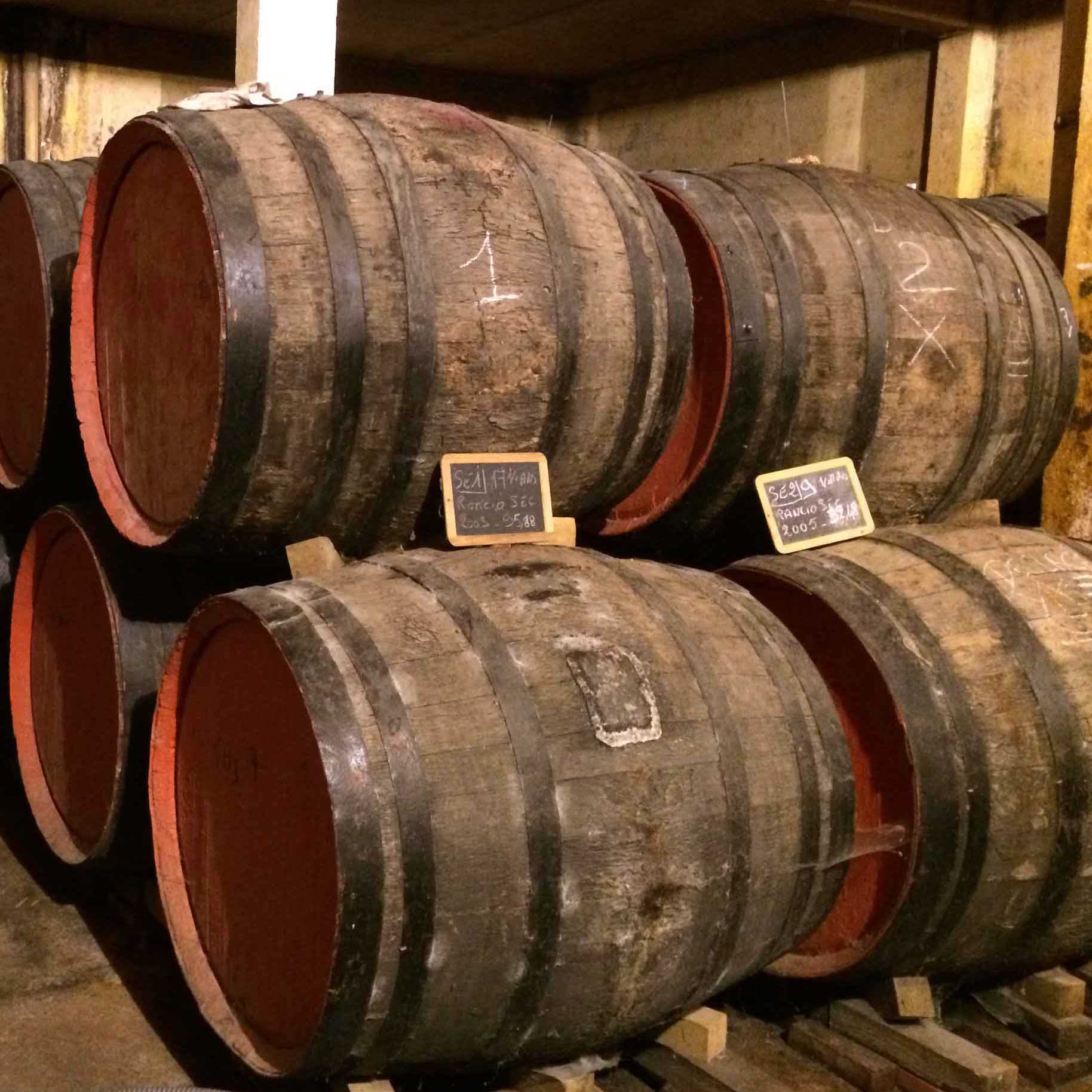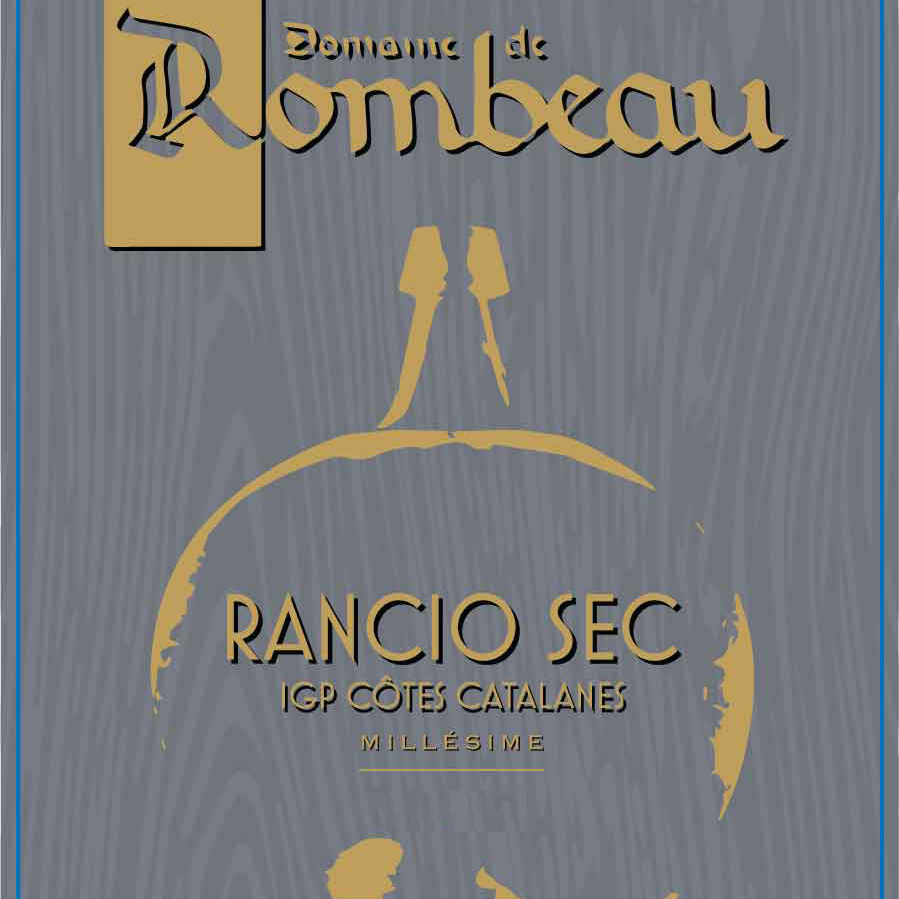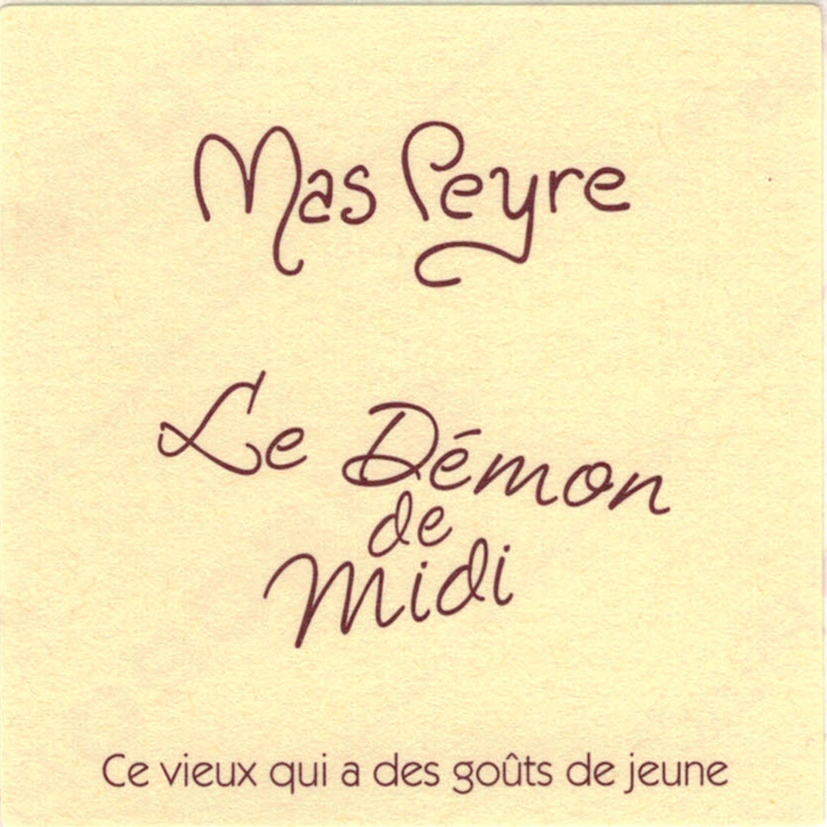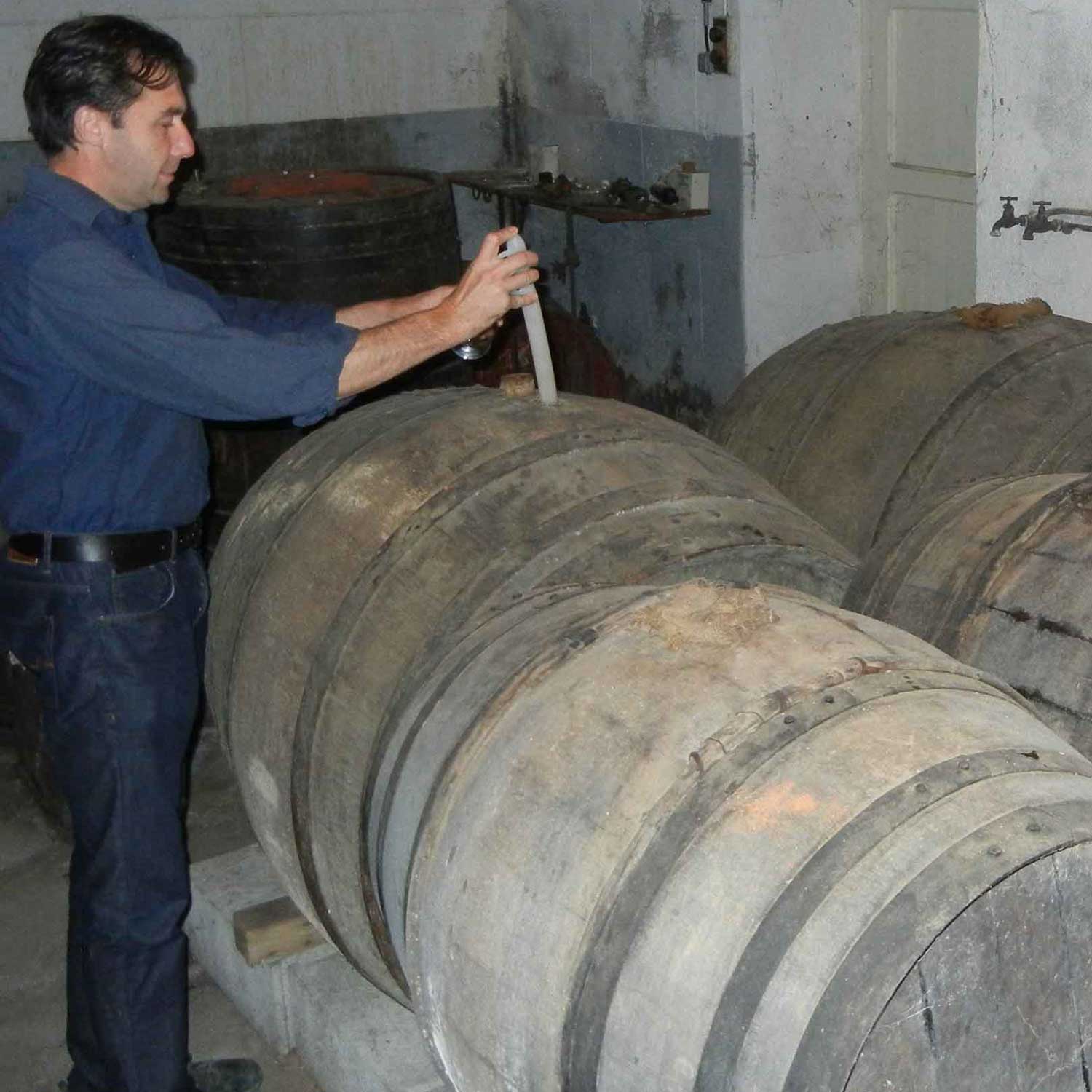Rancio Sec/Vi Ranci
Cataluyna is home to one of oldest forms of winemaking, a tradition of dry, aged, oxidative wines of a type that once would have been found along the Mediterranean coast, from Greece to Iberia. Known in Roussillon as Rancio sec (Vi Ranci, in Catalan), these are dry, unfortified wines made as they have been for more than two millennia: transformed by time, exposure to oxygen and, often, heat.
With the codification of fortified wines Rivesaltes, Maury and Banyuls under the appellation system in 1936, this ancient wine tradition nearly passed into history, surviving only as a proud and stubborn statement of Catalan identity and endurance. Harvested from passerillé old-vine grapes, the wines are fermented with native yeasts, sometimes taking years to complete fermentation. Elevage lasts a minimum of five years and can vary significantly from producer to producer. Wines may be left outside in glass demijohns (bonbonnes) or barrels during their first year, subjecting them to a kind of “thermal shock” before being moved inside to age in stores which boast only passive temperature control. The barrels are not “topped-up” and little or no sulfur is added, occasionally allowing the rare barrel to develop flor. The wines concentrate via evaporation, and levels of acidity and alcohol initially dip and then slowly rise, enabling the wine in question to resist spoilage as it gradually oxidizes. It is this oxidative evolution that gives rise to the complex array of notes and flavors (fresh walnut, curry spices, cocoa, light bitterness) that characterize Rancio sec. Like Madeira, the resulting wines appear to defy both time and the elements.
Made in minute quantities, Rancio sec was until recently served only on special occasions to a winemaker’s family and friends; its historic importance and endangered status recognized by Slow Food in 1989. Today, there is a quiet revival and recognition of its place in the modern world, as oxidative, umami-driven wines attract renewed interest. In Roussillon, Rancio sec is produced under the IGP Côtes Catalanes and IGP Côte Vermeille, while in Catalunya it falls under various regional appellations. Ideal as an aperitif, with all manner of pork preparations including barbeque, or after-dinner, Rancio sec is completely shelf-stable after opening.
Abbe Rous ‘Matifoc’ Rancio Sec NV
France ➜ Roussillon ➜ Côte Vermeille IGP 16.5% ABV
16.5% ABV • Fully Oxidized, Oxidative
A wine of ancient tradition, Abbé Rous ‘Matifoc’ Rancio sec is produced from old-vine Grenache noir and is aged outdoors in old 600-liter Banyuls demi-muids for up to four years before returning to the cellars for continued oxidative aging. The resulting wine is a blend, with an average age of 10-12 years in partially-filled barrels, resulting in its inimitable rancio character.
Full detailsTerres des Templiers Rancio Sec NV
France ➜ Roussillon ➜ Côte Vermeille IGP 16.5% ABV
16.5% ABV • Fully Oxidized, Oxidative
Terres des Templiers Rancio Sec descends from an ancient tradition preserved by Catalan winemakers of the Côte Vermeille. From old-vine Grenache noir found on its schist-dominated, terraced vineyards overlooking the sea, the wine is first aged out-of-doors in old demi-muids before returning to the cellars of the producer for extended oxidative aging in old Banyuls casks. The wine is a blend with an average age of 10-12 years spent in partially-filled barrels, resulting in its pronounced rancio character.
Full detailsTresmontaine ‘Puits aux Souhaits’ Rancio Sec NV
France ➜ Roussillon ➜ Côte Vermeille IGP 15.5% ABV
15.5% ABV • Fully Oxidized, Oxidative
Tresmontaine ‘Puits aux Souhaits’ Rancio sec is the last produced under the auspice of the late winemaker, Bernard Sapéras, who kept it mainly for family and friends. Made from Grenache noir vines with an average age of 70 years and a yield of just 20 hl/ha, it was fermented in old casks over the course of several years before coming to rest in barrels first used for the domaine’s Banyuls blanc. The average age of the blend is 10 years.
Full detailsDomaine de Rombeau Rancio Sec 2012
France ➜ Roussillon ➜ Côtes Catalanes IGP 16.5% ABV
16.5% ABV • Fully Oxidized, Oxidative
With echoes of single-malt Scotch—perhaps Speyside’s Abelour or Cardhu—the 2012 vintage combines a firmness and understated elegance unique amongst the Rombeau Rancio Sec vintages. Notes of bergamot, peanut brittle, green walnut and heather reveal themselves slowly along its subtly tannic spine. It was vinified in tank with native yeasts, then transferred to an assortment of old barrels and glass demijohns for 12-18 months' aging outdoors. A portion is then returned to the cellars, which rest above ground and lack temperature control, while another portion remained in the "barrel park" until the time of blending and bottling in mid-2022. The wine combines roughly equal parts Grenache blanc, Grenache gris and Macabeu, with a tiny amount of Muscat Blanc à Petits Grains.
It can be enjoyed with all manner of tapas, with cheese; with wood-fired pork or curried lamb, and especially as a digestif. Shelf-stable, it should be served lightly chilled or at cellar temperature.
Full detailsDomaine de Rombeau Rancio Sec 2011
France ➜ Roussillon ➜ Côtes Catalanes IGP 16.5% ABV
16.5% ABV • Fully Oxidized, Oxidative
With its inviting, redolent nose, the 2011 vintage serves as an exemplary invitation to the world of Rancio sec, its notes of caramelized apricot, tamarind and tobacco leaf delivered in a manner that is strictly analog. It was vinified in tank with native yeasts, then transferred to an assortment of old barrels and glass demijohns for 12-18 months' aging outdoors. A portion was then returned to the cellars, which rest above ground and lack temperature control, while another portion remained in the "barrel park" until the time of blending and bottling in mid-2022. The wine combines roughly equal parts Grenache blanc, Grenache gris and Macabeu, with a tiny amount of Muscat Blanc à Petits Grains.
This wine can be enjoyed with all manner of tapas, with cheese; with wood-fired pork or curried lamb, and especially as a digestif. Shelf-stable, it should be served lightly chilled or at cellar temperature.
Full detailsDomaine de Rombeau Rancio Sec 2010
France ➜ Roussillon ➜ Côtes Catalanes IGP 16.5% ABV
16.5% ABV • Fully Oxidized, Oxidative
The lightest of the Rombeau Rancio secs, the 2010 is distinguished by its cepage and its shorter elevage, with an increased percentage of Macabeu and, atypically, a small amount of Muscat à Petits Grains (roughly 10%) added to the foundational Grenache blanc and Grenache gris. It was vinified in tank with native yeasts, then transferred to an assortment of old barrels and glass demijohns for 12-18 months' aging outdoors. A portion is then returned to the cellars, which rest above ground and lack temperature control, while another portion remained in the "barrel park" until the time of blending and bottling in mid-2016.
Full detailsDomaine de Rombeau Rancio Sec 2009
France ➜ Roussillon ➜ Côtes Catalanes IGP 16.5% ABV
16.5% ABV • Fully Oxidized, Oxidative
The 2009 vintage is the most complete and balanced of the Rombeau Rancio secs, combining the pronounced umami funk of 2008 with the lighter touch of 2010. It was vinified in tank with native yeasts, then transferred to an assortment of old barrels and glass demijohns for 12-18 months' aging outdoors. A portion was then returned to the cellars, which rest above ground and lack temperature control, while another portion remained in the "barrel park" until the time of blending and bottling in mid-2016. The wine combines roughly equal parts Grenache blanc, Grenache gris and Macabeu, with a touch of the rare Malvoisie du Roussillon (Tourbat).
Full detailsDomaine de Rombeau Rancio Sec 2008
France ➜ Roussillon ➜ Côtes Catalanes IGP 16.5% ABV
16.5% ABV • Fully Oxidized, Oxidative
The most evolved of the Rombeau Rancio secs, the 2008 exhibits a pleasing "rancio funk" while nevertheless retaining its complexity and rough good manners. It was vinified in tank with native yeasts, then transferred to an assortment of old barrels and glass demijohns for 12-18 months' aging outdoors. A portion was then returned to the cellars, which rest above ground and lack temperature control, while another portion remained in the "barrel park" until the time of blending and bottling in mid-2016.
Full detailsDomaine de Sau Rancio Sec NV
France ➜ Roussillon ➜ Côtes Catalanes IGP 18.5% ABV
18.5% ABV
A blend of the 2006 and 2007 vintages, the Domaine de Saü Rancio sec is 100% Grenache gris, harvested by hand from a 1.9-hectare plot of 70-year old bush vines. Fermented with native yeasts in epoxy-line steel tanks and left for a week on its skins, its subsequent elevage takes place in one of the most magical places for oxidative wines in all of Roussillon—a former horse barn on the Château de Saü estate. Here, temperatures range from 55–80F and the Tramontana wind blows outside its wooden doors throughout the year, concentrating the wine left to rest in old 225-liter Bordelais fûts.
Full detailsDomaine Fontanel Rancio Sec 2007
France ➜ Roussillon ➜ Côtes Catalanes IGP 17.0% ABV
17.0% ABV • Fully Oxidized, Oxidative
This is a rare example of what is one of the oldest forms of winemaking, once found throughout the Mediterranean and now preserved by Catalan tradition on both sides of the French-Spanish border. The grapes are hand-harvested and fermented with native yeasts, without fortification. The youngest vines informing this wine date from 1946; the oldest from 1908. Exposed to the elements and aged for many years in partially filled oak barrels, the resulting wine has what the Roussillon locals call le goût de soleil, the taste of the sun: dry and concentrated, with complex rancio flavors of walnuts, cocoa and curry spices. This wine slumbered in barrels until May 2018.
Full detailsDomaine Jorel ‘La Garrigue’ Rancio Sec 2003
France ➜ Roussillon ➜ Côtes Catalanes IGP 16.0% ABV
16.0% ABV • Fully Oxidized, Oxidative
Manuel Jorel’s first Rancio sec was the result of the scorching 2003 vintage and amongst the most unique in the Sotolon Selections portfolio. His small parcel of Macabeu grapes began to shrivel on the vine; he picked the grapes and set about making an ‘orange wine’ with them, leaving the emerging wine on the skins for 28 days. It began to oxidize and he feared the wine lost, but with the advice of an old-timer, he racked the wine into old Rivesaltes casks in the corner of his second cellar (which then doubled as a garage, or garrique).
Full detailsMas Peyre ‘Le Démon de Midi’ Rancio Sec NV
France ➜ Roussillon ➜ Côtes Catalanes IGP 17.0% ABV
17.0% ABV • Fully Oxidized, Oxidative
The Bourrel family inaugurated this solera of overripe, old-vine Macabeu grapes in 2005. Grapes are harvested by hand at 254 g/l residual sugar and, placed into the first of three barrels, are allowed to slowly ferment to dryness. Subsequent elevage in the partially-filled barrels creates an oxidative environment; bottled at an average of six years of age, the ‘Démon de Midi’ (noonday demon) takes on notes of almond, garrigue honey and leather, with a touch of salt emerging at the finish.
Full detailsPuig-Parahÿ ‘Pyror’ Rancio Sec NV
France ➜ Roussillon ➜ Côtes Catalanes IGP 18.5% ABV
18.5% ABV • Fully Oxidized, Oxidative
The barrels that winemaker Georges Puig blends to produce ‘Pyror’ were first set down in the early 1960s by his father and grandfather, and have been maintained as "perpetual barrels" ever since, with small amounts withdrawn every few years. The wine—equal parts Grenache blanc, Grenache gris and Macabeu—slowly concentrates in the ancient oak and chestnut barrels, gaining a particular combination of polish and rusticity.
Full detailsTresmontaine ‘Tabacal Dos’ Rancio
France ➜ Roussillon ➜ Côtes Catalanes IGP 17.0% ABV
17.0% ABV • Fully Oxidized, Oxidative
A Catalan tradition, Rancio wines such as this predate the modern conception of wine and viticulture. This wine’s rustic character begins with a full fermentation and evolves first in glass demijohns and then in used oak barrels, which are partially filled and often out in the sun. Owing to the process, the climate, and character of the grapes, the wine is oxidative and rich with earth, smoke and mushroom notes. This wine has aged over 5 years in barrels that formerly housed the eponymous wine of its village, lending a unique depth. Enjoy with cured meats and cheeses, or with rich creamy desserts. Serve either lightly chilled or at cellar temperature.
Full detailsTresmontaine ‘Tabacal’ Rancio NV
France ➜ Roussillon ➜ Côtes Catalanes IGP 17.0% ABV
17.0% ABV • Fully Oxidized, Oxidative
Tresmontaine ‘Tabacal’ Rancio is the last Rancio produced by legendary Roussillon winemaker Fernand Baixas at Arnaud de Villeneuve, prior to his "retirement." (He can now be found with other raconteurs at nearby Domaine de Rombeau.) The blend is 100% Grenache blanc from the 2002 and 2003 vintages, exposed to the elements in glass demijohns for 18 months, then returned to the cellars to rest in old foudres and barrique for an additional 10 years.
Full detailsEspodol Vi Ranci Sec NV
14.0% ABV • Fully Oxidized, Oxidative
While the tradition of Vi Ranci and Rancio sec has survived in both Catalunya nord and sud along the French-Spanish border, the large majority of those now produced in Spain are fortified. Espodol Vi Ranci Sec is the rare unfortified expression: Old-vine Garnatxa blanca and Garnatxa rosat, hand-harvested and co-fermented under the rafters in epoxy-lined concrete tank. The wine destined to be bottled as Vi Ranci Sec then enters a languorous three-tier solera that was inaugurated in 1950, where a portion of the slowly oxidizing wine is transferred from tank to large foudres and finally to 300-600L barrels. These movements typically occur only once every 3-4 years, with small quantities from the solera bottled just once per year.
Full details
















































